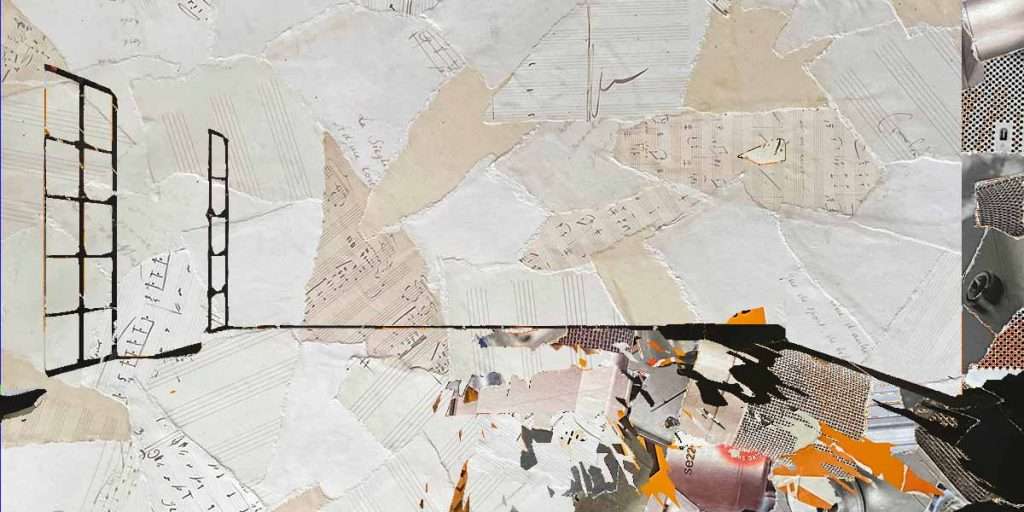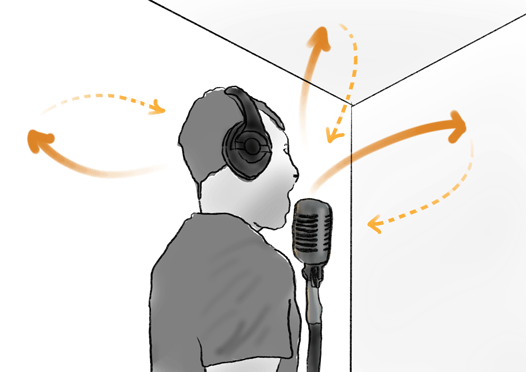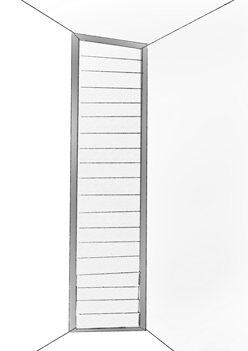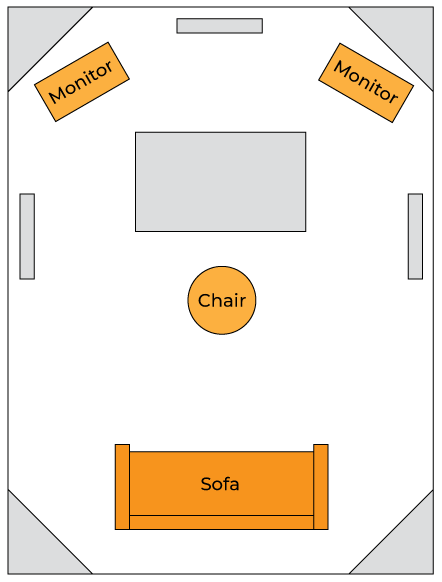Acoustic Treatment for the Home Studio
Make any room sound like a pro studio with the right acoustic treatment.

The missing secret that most home recording studio owners neglect is acoustic treatment.
It’s easy to see why.
Acoustic treatment remains a mystery for so many beginners.
It’s often confused with soundproofing, which is stopping sound getting in or out of the room.
But acoustic treatment is about the quality of the sound in your studio. And it’s just as vital as quality equipment for making pro-level recordings.
- What are acoustics?
- Assess your room
- Early reflections
- Absorbing bass frequencies
- Types of acoustic treatment
- Acoustic foam
- Acoustic panels
- How to make an acoustic panel
- Bass traps
- How to make a bass trap
- Diffusers
- Furniture as acoustic treatment
- Where to place acoustic treatment
- Working with poor acoustics
The sound of a room
Every room has its own sound. It’s something we’ve become so accustomed to that we barely notice it until there’s a big change.
It becomes obvious when you shout down a long tunnel, or sing inside a stone cathedral. Each of these environments shape the sound in their own ways, reflecting it back as a blanket of reverb.
Rooms in houses tend to be on the smaller side. They also have their own sound. But the rectangular shape and parallel walls make their acoustic far from ideal.
Do acoustics matter?
Acoustic treatment is vital for two purposes:
- Recording
When you record a vocalist, the mic picks up the direct sound of the singer, as well as the sound of the room.

This is because the singer’s voice bounces off the walls and furniture, arriving at the microphone a few milliseconds after the direct sound.
This colours the sound of the voice with the sound of the room you’re recording in. And you’re stuck with that sound.
With acoustic treatment, you can minimise the sound of the room, and capture the pure sound of the voice.
This signal can be processed with artificial reverb to make it sound like it was recorded anywhere. From Notre Dame to Abbey Road studios.
- Mixing
When you’re listening back to a recording, you’ll hear the direct sound of the monitors, as well as the sound of the room.

This is because the speaker’s signal bounces off the walls and furniture, arriving at your ears a few milliseconds after the direct sound.
This means its difficult to hear your mix accurately. And if you can’t hear accurately, your mixes will be off when you play them back on another system.
Assess your room
Walk around the room and clap your hands.
Listen to the sound.
The bigger and emptier the room, the more chance you’ll hear a nice reverb. But for most of us, in small boxy rooms, we’re likely to hear a nasty ringing sound. It’s the sound of the clap bouncing back and forth between parallel walls. This is called flutter echo.
The ideal sound of a room
Let’s assume that you plan to do both recording and mixing in the same room. This is how many home recording studios operate today.
Aim for acoustic treatment which eliminates most of the reflections, but doesn’t leave the room sounding completely dry.
So how do you do this?
By strategically placing sound absorbing objects in the room. Medium and high frequencies are quite easy to eliminate. But low frequencies are more problematic.
Room layout and monitor placement
Before acoustic treatment, consider the layout of the room.

Place your speakers symmetrically, along the narrowest wall. This will direct the sound along the length of the room.
They should be head height, the tweeter (smallest cone) level with your ears. The two monitors should form an equilateral triangle with the listener.
Early reflections
Picture yourself sitting in a chair, in front of your monitors.
As well as directing sound towards you, the speakers are emitting sound in every other direction. The lower the frequency, the less directional the sound.
Much of that sound bounces off the walls and ceilings, and back to your ears. It merges with the direct sound from the monitors. If you were in a massive room, you’d hear an echo instead.
You can actually map out the path of the sound as it leaves the speaker, reflects off the wall, and reaches your ears. Sit in your listening position, or sweet spot, and ask a friend to hold a mirror flat against the wall. Let them move it around, until you can see one of your monitors. This is the area to place an acoustic panel.

The acoustic panel will absorb the sound from the speaker, rather than reflect it towards you.
After playing around with a mirror, you should have an area on both walls to your sides, as well as the ceiling above. Place an acoustic panel in each of these three areas.
You can also place acoustic panels behind each speaker, to help absorb the sound coming from the back of the speaker. A lot of that sound will be low frequency, which needs separate consideration.
Absorbing bass frequencies
This is the area of sound which causes most problems for home recording studios. The lower the sound, the more difficult it is to absorb. Especially in smaller rooms.
This is because low frequency sound waves are long. The lowest note on a bass guitar is around 41 hertz (Hz). That’s a mega 27 foot long sound wave!
To absorb these large sound waves, the acoustic panels need to be really deep. There’s ones made specifically for low frequencies, called bass traps. They’re placed in the corners of rooms, where bass frequencies congregate.

Different types of acoustic treatment
Different forms of acoustic treatment absorb different frequencies. It’s important to get a balance for a natural sounding room.
The denser and heavier the treatment, the lower the frequency absorbed. Don’t make the mistake of only using lightweight solutions, such as foam or carpet. This will only absorb the highest frequencies, resulting in a worse sounding room
Most acoustic treatments use a combination of the following:
Acoustic foam
This is similar to the foam found in furniture.
It’s lightweight, and great for absorbing high frequencies. If thick enough, it can also be effective for medium frequencies.
Acoustic foam comes in tiles of various sizes and thicknesses. The thicker they are, the lower the frequency they can absorb. 4″ foam is good for sound down to around middle C on a piano.
Adding an air gap behind the foam will massively increase the effectiveness at lower frequencies. Aim for a gap of between 2 and 4 inches.
| 1 inch (25mm) foam | Effective above 1 khz |
| 2 inch (50mm) foam | Effective above 500 hz |
| 4 inch (100mm) foam | Effective above 250 hz |
Foam tiles can be flat faced, or have ridged or egg box style profiles. A textured surface helps to absorb more frequencies. But it also means less foam, so not quite as effective as at lower frequencies.
Gator do a nice set of 8 pyramid foam panels, available in a range of colours – purple, orange, charcoal burgundy, green and red. Or pick up a 12 pack of Sonic Acoustics Hexagon Acoustic Panels from Amazon if you’re looking to treat higher frequencies – they come in flat and 3D versions, in every colour you could think of.
Acoustic panels
Acoustic panels are soft rectangular panels used for absorbing medium and high frequencies. They’re usually made from fiberglass or mineral wool slab, which are denser than foam.
You’ll also find them made with foam, but these work more like the acoustic foam tiles. The thicker the panel, the lower the frequency which can be absorbed.
| 2 inch (50mm) mineral wool | Effective above 200 hz |
| 4 inch (100mm) mineral wool | Effective above 100 hz |
The acoustic panels can be placed at the main reflection points. Hang them on the wall, preferably with an air gap of a few inches to increase the bass response.
I also have some acoustic panels on stands, so I can move them around to change the acoustic when recording.
I love the look of these full size t.akustik foam panels, finished in oak. They won’t be quite as effective as homemade, mineral wool panels (see below), but should start having an effect at around 350 Hz.
As an alternative to acoustic panels, use can use thick acoustic blankets on a rail. Acoustic blankets are heavyweight blankets made with mineral wool. Some blankets come with an absorbent side for sound reduction, and a reflective side for a brighter sound.
If you get a clothes rail with wheels, it’s easy to move them about to suite any recording, or monitoring situation.
How to make an acoustic panel
Acoustic panels can be made with basic DIY skills. Mineral wool is available in semi-rigid 2 x 4 foot (or 600 x 1200mm) slabs. Buy a four pack of around 45kg/m3 density, 4 inch (or 100mm) thick.
The slabs are actually fully functioning acoustic panels out of the box. But they’re delicate and need a frame around them. And they need covering with material because they’re made of fibers that can irritate your skin.
1. Build a frame

Build a simple wooden frame around the mineral wool slab, using four lengths of 3/8 inch (or 10mm) timber.
If you’re using 2 x 4 foot mineral wool slabs, cut 2 x 2 foot 3/4 inch, and
2 x 4 foot lengths. Screw the frame together with 2 screws per corner.
2. Seal the mineral wool
Mix up a solution of 1 part PVA glue, 9 parts water. Put it into a sprayer, and spray the mineral wool surfaces. Do this for the front and the back. This will bond any stray fibers.
3. Cover frame with material

Choose a porous material which allows sound waves to pass through. You can check this by making sure you can breath through it.
Cover the front of the frame first, pulling the material tight and stapling it into place on the back of the frame.
4. Cover back of panel

Cut out some more material for the back panel, and staple or glue it into place on the frame.
Bass traps
Bass traps are extra deep acoustic panels. The extended depth helps to absorb the longer sound waves of low frequencies, which build up in the corners of rooms.
Many bass traps work as broadband absorbers, meaning they absorb everything from low frequencies to the highest.
This makes bass traps the priority acoustic treatment for your home recording studio.
Bass traps should be placed in the corners of your room, where low frequencies collect. Avoid the tiny foam traps from Amazon, as they won’t have much effect on the bass. There’s better options, such as these bass traps by Auralex, which are twice the size. Or take a look at these stylish cylindrical Hofa bass traps, in a range of colours.
But for the most effective bass reduction, I recommend making some yourself with mineral wool or fiberglass.
| 8 inch (200mm) mineral wool | Effective above 50 hz |
| 12 inch (300mm) mineral wool | Effective above 25 hz |
How to make a bass trap (7 steps)
For a simple solution, follow the instructions for making acoustic panels, but make them double the thickness.
Place these thick panels in the corners of you room, so there’s a triangular air gap behind them.
But for a more permanent, and elegant solution, you can build full height bass traps into the corners of the room. Use mineral wool of around 45kg/m3 density, 4 inch (100mm) thick.
Each slab can be neatly cut into 4 triangles, which are stacked to fill the corners.
1. Measure the corner height
Measure the distance between the floor and the ceiling. To see how many mineral wool slabs you’ll need per bass trap:
In inches: divide the height by 16.
In cm: divide the height by 40.
2. Cut the mineral wool

Use a hand saw to cut each mineral wool slab into four equal triangles. Stack them neatly into the corner of the room.
3. Stack the triangles

Keep stacking the triangular mineral wool pieces until you’ve reached the ceiling.
4. Seal the mineral wool
Mix up a solution of 1 part PVA glue, 9 parts water. Put it into a sprayer, and spray the mineral wool surfaces. This will bond any stray fibres.
5. Make a frame

Make a wooden frame around the corner so you can attach a fabric cover.
For the floor and ceiling, use 1 x 1 inch (25mm) batons. For the walls, use 1 inch triangular beading, either store bought, or by cutting the batons in half. Screw these directly onto the wall.
6. Make a fabric panel

Use 1 x 1 inch batons to construct a rectangular wooden frame, the same size as the frame on the wall. Make the height 1/4 inch (6mm) smaller – it will be easier to fit.
Stretch breathable fabric over the frame and staple it into place around the back of the frame.
7. Screw the panel to the frame

Position the fabric panel onto the wall frame, and screw into place.
The bass trap is ready.
Diffusers
Diffusers are reflective panels which scatter sound in different directions. They’re good for controlling reflections without making the room sound too dry.
You probably won’t need diffusers for your home recording studio, as they’re not that effective in small rooms.
In larger rooms, diffusers like this can be placed along the back wall, to scatter late reflections.

Furniture as acoustic treatment
Everything piece of furniture contributes to the sound of the room. You can be strategic by arranging the furniture to get the sound you want.
Sofa
An upholstered sofa at the back of the room can work as a sound absorber. The bigger and heavier the sofa, the more effective it will be at lower frequencies. Throw some cushions and a throw over the sofa to increase the absorption.
Curtains
Heavy, dense curtains will absorb some medium and high frequencies. Look for a weight of around 1kg per square metre or more. You can double the mass by installing 4 pairs in place of 2.
Rugs and blankets
Thick rugs and heavy wool blankets can soak up high frequency reflections. Bunch them up and hang them from on the wall, with an air gap of a few inches. You can also hang them on a clothes rail and move them around.
Carpet
Carpet or rugs on the floor can help tame a reverberant room by absorbing high frequencies.
Don’t make the mistake of carpeting every surface of your room. This will only absorb high frequencies. You’ll be left with a dull boxy sound.
Duvet/comforter vocal area
You can use 2 thick comforters to make an improvised vocal recording area. Hang them in the corner of a room with a few inches of space in between.
The singer stands close to the mic, with their back to the duvet. This stops reflections from the corner of the room coloring the sound.
Bookcase diffuser
Put shelves or a stylish bookcase at the back of the room. Fill them with your cables, equipment and manuals. This will provide a random surface which will act as a diffuser. It will scatter sound waves in different directions.
Where to place acoustic treatment
Every room is different and will need its own considerations. But there is a general blueprint for home recording studios which is a good place to start.
- Place an acoustic panel at the reflection points on either side of the listener
- Place an acoustic panel at the reflection point above your head on the ceiling
- Place an acoustic panel, or bass trap (if in corner) behind each monitor
- Place bass traps in all accessible corners. If there’s limited wall to wall corners, fit them in wall to ceiling, or wall to floor corners

Working with poor acoustics
If you’re working in an area where you can’t make any improvements to the acoustics, follow these tips:
- Close miking
Set the microphone up as close as you can to the vocalist or instrument. This will ensure the maximum amount of direct sound to the mic.
- Use a dynamic mic
Dynamic microphones are less sensitive than condenser or ribbon mics. Use one to minimise the sound of the room in your recordings
- Choose suitable monitors
In a small or untreated room, it makes no sense to have big monitors. Choose smaller monitors with less bass response and a smooth bass roll off. You’ll get a more accurate representation of what you’re listening to.
- Use headphones
Consider using a pair of quality open backed headphones for mixing. You’ll completely bypass the sound of the room, and hear a new level of detail.
- Choose a soft room
Set up in a room which already has soft furnishings, such as a sofa and curtains. Bring in extra clothes, blankets and duvets from other rooms to help absorb the sound.
The bottom line
However much time and money you spend on recording equipment, you’ll always be limited by the room you’re recording in.
Some basic acoustic treatment, especially in the low frequency range, will result in clearer recordings and accurate mixes.
Acoustic treatment is the magic ingredient that so many newbies neglect. It really is the missing link for making pro quality recordings.
Once the acoustics are suited, a good mic will sound fantastic, and your studio monitors will deliver exactly what you need to hear.
Education is the key to getting a pro sound. I’ve made a guide to help you choose the Best Online Music Production Courses available right now
Author: Daren B

Daren studied classical piano and composition at Trinity College of Music, at undergraduate and postgraduate level.
His music has been performed at the Southbank Centre, Tate Modern, and the Courtauld Institute, and broadcast on BBC Radio 3, Radio 4 and countless TV shows, including The Apprentice, Top Gear and Horizon.
Daren is a former lecturer on the BA Music Course at Goldsmiths College, University of London. He currently works in London as a composer and psychotherapist.




